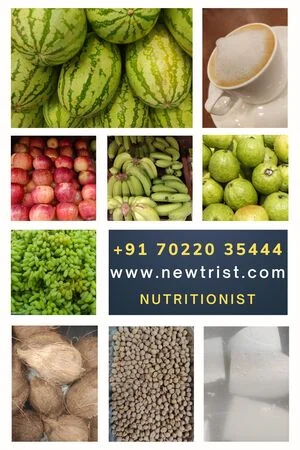Newtrist Nutritionist Lichen Sclerosus Diet Plan consists of low-oxalate, calcium-rich fruits, vegetables, whole grains, dairy products, herbs, lean poultry, fish, and healthy oils such as olive oil and unrefined vegetable oils.
- Early morning drink @ 6:30 am: Milk coffee
- Breakfast @ 9 am: Gobi paratha with curd
- Mid-morning meal @ 11 am: Lightly steeped green tea
- Lunch @ 1 pm: Rice with fish curry and a slice of watermelon
- Evening snack @ 4 pm: A cup of washed green/red grapes
- Dinner @ 7 pm: Whole wheat roti with channa curry
Best Nutritionist in Bangalore
Consult 19-year-experienced Chief Nutritionist Vasanthi, in person at HSR, Koramangala, Bellandur, Haralur, Electronic city, or online across India.

Table of Contents
What is Lichen Sclerosus?
Lichen Sclerosus, often referred to as “White Spot Disease” is characterized by thin, white patches of the skin which are painful and tear off easily with an itch. Lichen Sclerosus may appear randomly anywhere on the skin, but it is commonly found in the vulva, surrounding the anus, and penis in men.
Postmenopausal women who show a significant lack of estrogen are more prone to this condition. The disease may show symptoms at any age. Lichen Sclerosus is often accompanied by other autoimmune conditions such as rheumatoid arthritis which mainly affects the bones. It is essential to provide a calcium-rich diet for those affected with this condition to maintain bone health and prevent the risk of fractures and other related problems.
The primary cause of the disease is unclear whereas, immune reactions, genetic, and environmental factors may be linked to the onset of the disease. Low levels of estrogen and other hormonal imbalance might trigger these types of conditions in the body
Steroid ointments are commonly used for treating Lichen Sclerosus. The disease cannot be cured completely but the symptoms such as itching and burning can be managed with herbs and topical corticosteroids. It is advised not to use strong detergents, perfumed soaps, scented shampoos, and bubble baths to avoid aggravation of the condition.
What are the symptoms of Lichen Sclerosus?
A few symptoms of Lichen Sclerosus are
- Itchiness
- Fragile skin
- Dry and wrinkled skin
- Easy bruising
- Discolored patchy skin
- Narrowing of the urethra
- Bleeding of the blisters and sores
- Painful intercourse
- Burning feeling
- Scarring of the affected areas.
The areas surrounding the vagina, anus, and penis are the most affected areas that cause itchiness, irritation, and discomfort. Sores and blisters may result from persistent itching on the genitals. Minimal friction like tight clothing can cause the blisters to break down.
Untreated Lichen Sclerosus may lead to difficulties in urinating due to inflammation of the urethra. Some may face constipation and irregular bowel movements. Lichen Sclerosus may increase the risk of squamous cell carcinoma which is a type of skin cancer.
What are the stages of Lichen Sclerosus?
Lichen Sclerosus may start with lesions that may appear as small white or pink bumps which become patchy and causes pain and itchiness. Light scratching may tear off the skin and cause bleeding due to tender skin.
What are the types of Lichen Sclerosus?
The three types of Lichen Sclerosus are
- Lichen Sclerosus et atrophicus (LSA)
- Leukoplakia Kraurosis vulvae (in women)
- Balanitis Xerotica Obliterans (in males)
Foods to avoid with Lichen Sclerosus
Foods to avoid with Lichen Sclerosus include high-oxalate foods such as spinach, nuts, almonds, pistachios, cashews, peanuts, seeds, beetroot, potatoes, okra, eggplant, kiwis, dates, turnips, yams, carrots, kidney beans, cocoa, chocolate, brown rice, tofu, soybeans, tomato sauce, green beans, and cucumber.
Other foods to avoid are
- Sugary foods
- Refined grains such as white bread, noodles, and pasta
- Candies and sweets
- Carbonated beverages
- Processed foods such as chips and snacks
- Processed meats such as hotdogs, sausages, and salami
- Readymix soups
- Boxed cereals
- Chocolates and hot cocoa drink
- Ice cream and whipped cream
Oxalate is naturally produced in the body as a result of metabolism. Oxalates cause flare-ups of the symptoms of Lichen Sclerosus. Reduced oxalate intake lowers the inflammation of the vulva and anal region.
Foods with added sugars induce inflammation and make the condition even worse. Always remember that fruits and vegetables contain natural sugars that benefit the body in numerous ways.
Consuming oxalate-rich foods with calcium-rich foods is considered beneficial as the calcium combines with oxalates to form calcium oxalate which reduces the oxalate absorption in the cells of the body.
Lichen Sclerosus Diet Plan
- Early morning drink @ 6:30 am: Tulsi tea
- Breakfast @ 9 am: Vegetable Dalia with paneer
- Mid-morning meal @ 11 am: Apple-banana smoothie
- Lunch @ 1 pm: Mushroom pulav with onion raita
- Evening snack @ 4 pm: Chana dal dhokla
- Dinner @ 7 pm: Oats dosa with coconut-mint chutney

Best vegetables for Lichen Sclerosus
Below are a few vegetables good for Lichen Sclerosus
- Cabbage
- Cauliflower
- Peas
- Broccoli
- Mushrooms
- Onions
- Garlic
- Lettuce
- asparagus
- Zucchini
- Radishes
- Gourd vegetables
Intake of fibrous foods like vegetables aid in reducing inflammation and provide you with the essential micro and macronutrients required by the body. Vegetables like onions, garlic, turmeric, and herbs boost immunity and prevent the flare-up of symptoms.
An elimination diet that excludes high oxalate vegetables protects from inflammation and other issues of Lichen Sclerosus. When excreted in the urine, high oxalates may cause irritation of the lesions and a burning sensation in the vulvar region.
Best fruits for Lichen Sclerosus
Some of the best fruits to consume for Lichen Sclerosus are
- Apples
- Bananas
- Guavas
- Strawberries
- Cherries
- Peaches
- Lemons
- Apricots
- Cantaloupes
- Honeydew
- Watermelon
- Coconut
Fruits promote hydration and prevent dryness of the skin. Avoid adding sugar to fruit juices to stay away from the ill effects of sugars as they tend to aggravate inflammation. Restrict the intake of oranges, tangerines, kiwis, and raspberries as these fruits contain a high oxalate content. Fruits tend to reduce inflammation and regulate bowel movements and prevent constipation.
Tips for Lichen Sclerosus
- Use a soap with a neutral pH or a non-soap cleanser instead of regular soap. Ask your dermatologist for suitable products for your skin.
- Tap dry the affected areas with a clean towel and apply the ointments as prescribed by the health care provider or petroleum jelly to ease itching
- Wear soft underwear made of cotton and avoid wearing tight and restrictive clothes
- Have a clear idea about the high-oxalate and low-oxalate foods to include or avoid from the daily diet
- Include calcium-rich foods to reduce the effects of oxalates in the body
- Drink plenty of water to keep yourself hydrated and to flush out the toxins from the body
- Avoid scratching of the affected skin as the skin may tear off with a light bruising.
- Do not wash the underwear with harsh detergents and use only water
- Avoid the intake of inflammatory foods such as refined foods, and fried food items
- Avoid vigorous activities such as cycling and horse riding until the symptoms subside
- Consult a dermatologist if you notice symptoms of Lichen Sclerosus.

Foods to prevent Lichen Sclerosus
A wise selection of fruits, vegetables, poultry, and fish lowers the symptoms of Lichen Sclerosus such as itching, burning sensation, and inflammation. However, no particular diet can prevent the onset of the condition as it occurs mainly due to the immune reaction toward the own antibodies.
Reduced intake of high oxalate foods helps in the effective management of the symptoms and lowers the chances of recurrence.
Lichen Sclerosus FAQs
Is Lichen Sclerosus curable?
Lichen Sclerosus is a lifelong condition with no complete cure. Regular application of steroid ointments and dietary modifications helps in controlling the symptoms. Untreated Lichen Sclerosus may lead to squamous cell carcinoma in its severe stages. Corticosteroid ointments provide relief and prevent Lichen Sclerosus from getting worse.
What are the best foods to eat for Lichen Sclerosus?
Fruits and vegetables low in oxalate, calcium-rich foods, whole grains, lean poultry, and fish are some of the best foods to eat for Lichen Sclerosus. Consuming antioxidant-rich foods and foods that contain anti-inflammatory properties is beneficial for the condition. Take a step back from consuming sugary foods, and fried, and processed foods for better management of the symptoms.
What is the natural remedy for Lichen Sclerosus?
A few natural remedies such as turmeric, aloe vera, and neem leaves can reduce the flare-ups of the symptoms of Lichen Sclerosus. Natural treatments may not cure Lichen Sclerosus but ease the symptoms such as itching and burning. Remove foods from the diet that triggers inflammation and auto-immune reactions. Some of the natural remedies can prevent scarring.
How can I reduce Lichen Sclerosus?
Lichen Sclerosus can be reduced with the help of an elimination diet that consists of oxalates and the application of corticosteroid ointments and creams that contain vitamin E over the affected areas. Lichen Sclerosus is a non-contagious disease that irritates with the use of strong soaps, detergents, and bubble baths. It is advised to stay away from irritants and follow certain tips mentioned above for the betterment of the symptoms.
Are vitamins and calcium good for Lichen Sclerosus?
Patients with Lichen Sclerosus report a high deficiency of vitamin D and B12 due to the restriction of many foods rich in oxalates. Intake of calcium-rich foods is recommended as the dietary calcium binds with the oxalate to form calcium oxalate and gets excreted through the vulva and anal region. Oxalate is the main source that promotes inflammation and makes the condition worse.
What are the first signs of Lichen Sclerosus?
Itchiness, pale and wrinkled skin, burning sensation, easy bruising, and discolored patchy skin are some of the first signs of Lichen Sclerosus. The lesions may start as white or pink bumps that become patchy like tissue paper. These patches may be painful and cause discomfort. Bleeding may also occur on slight scratching of the affected areas. The symptoms may vary from person to person based on the severity of the condition.
Is Lichen Sclerosus a serious condition?
Untreated Lichen Sclerosus can cause scarring and pain while passing urine and bowel movements. Patients with Lichen Sclerosus also carry the risk of skin cancer at the vulva or the penis. Lichen Sclerosus cannot be cured but the symptoms can be managed with diet and treatments. Lichen Sclerosus may not be serious, but it may cause extreme discomfort.
How can I treat Lichen Sclerosus at home?
Taking care of the affected areas and applying petroleum jelly such as Vaseline can soothe dryness and make you feel better. Clean the affected areas with mild and unscented soaps or with plain water and apply ointments or creams as prescribed by the health care provider. Limit the intake of foods that contain oxalates and excess unhealthy fats.
How to reverse Lichen Sclerosus?
Lichen Sclerosus can be reversed with steroid ointments and modifications in the diet. the dermatologist may advise you to apply the cream/ointment twice a day which may reduce to once a day as the symptoms subside. However, Lichen Sclerosus might not be reversed completely and the symptoms may reappear after the remission period. The disease can last for years and cause permanent scarring in a few cases.